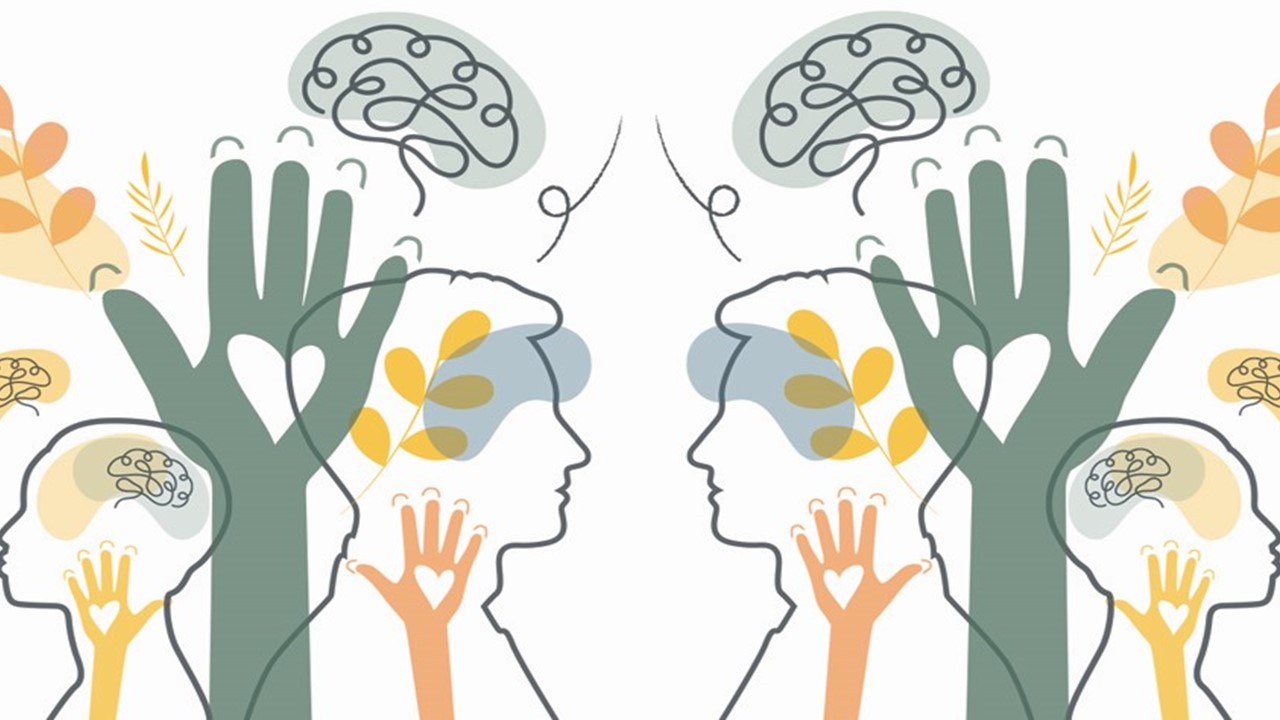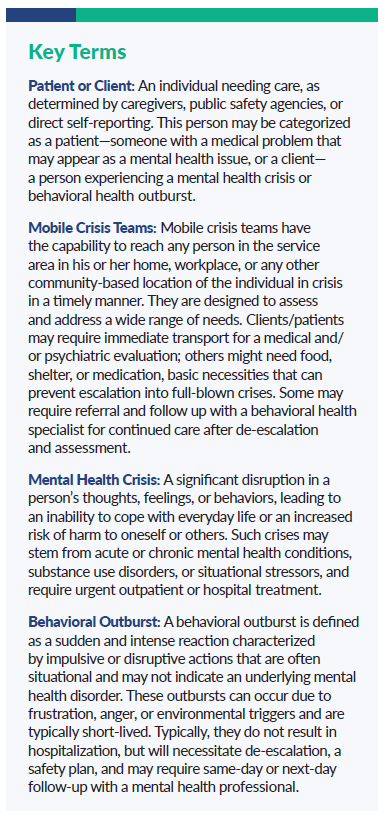
“No man is an island entire of itself; every man is a piece of the continent, a part of the main; if a clod be washed away by the sea, Europe is the less…any man’s death diminishes me, because I am involved in mankind. And therefore never send to know for whom the bell tolls; it tolls for thee.”
—Meditation XVII, Devotions upon Emergent Occasions, John Donne
The definition of a behavioral health crisis is “the experience of stress, emotional or behavioral symptoms, difficulties with substance use, or a traumatic event that compromises or has the ability to negatively impact an individual’s ability to function within their current family or caregiver environment, living situation, school, workplace, or community, as defined by the individual experiencing the crisis or by a parent, caregiver, guardian, or designee of the individual as appropriate.”
The need for mobile crisis response teams in the United States has become increasingly apparent. High-profile incidents across the United States underscore the inadequacy of traditional law enforcement responses to behavioral health crises. Such crises often involve disruptions in mental or emotional stability requiring immediate intervention to prevent severe health deterioration. In the United States, the numbers are staggering:
1. One in five adults experiences a mental illness during their lifetime.
2. Over 12 million people have serious thoughts of suicide annually.
3. Nearly a quarter of those shot by police from 2015 to 2020 had a mental health condition.
4. Two million individuals with serious mental illnesses are incarcerated annually.
These figures highlight the urgent need for community-based mobile crisis response teams that address behavioral health emergencies without relying solely on police intervention. Behavioral health incidents are complex scenarios that require a multi-disciplinary approach in order to achieve a measure of resolution.

Traditional single-agency approaches, such as law enforcement or EMS responding alone, may not fully address the complexities of behavioral health crises,
often leading to unnecessary hospitalizations, incarceration, or escalation. A multi-disciplinary mobile crisis response—incorporating behavioral health practitioners, paramedics or EMTs, peer support specialists, and social workers—ensures a more comprehensive approach that prioritizes de-escalation, medical assessment, and connection to appropriate resources.
By integrating expertise from different fields, these teams can reduce the risk of injury, improve patient outcomes, and divert individuals from the criminal justice system or emergency departments when more appropriate community-based care is available. This collaborative model enhances situational awareness, ensures trauma-informed care, and builds public trust in crisis response systems. This is not to say that law enforcement does not have a role in these types of responses, but what that role embodies needs to be carefully considered.
The immediacy surrounding the need for mobile crisis response teams has been exacerbated by the COVID-19 pandemic, amplifying global mental health challenges. The World Health Organization reports a 13% rise in mental health conditions and substance use disorders over the last decade, with depression now one of the leading causes of disability. Despite these statistics, government health spending on mental health remains below 2% globally, leaving many communities unprepared to handle the growing demand for services.
Community Resources and Challenges
A needs assessment is a fundamental tool for public health. Successful programs begin with a community needs assessment to identify gaps in behavioral health resources. A community needs assessment for a crisis mobile response team is a systematic evaluation designed to identify the specific behavioral health needs and service gaps within a particular community. This assessment should evaluate existing support, such as law enforcement, emergency departments, and outpatient services, while considering new approaches like telehealth for rural or underserved areas.
Determining the appropriate structure for mobile crisis response services requires careful consideration of community size, population demographics, and available local resources. Larger urban areas (urbanized areas with a population of 50,000 or more or urban clusters with at least 2,500 but fewer than 50,000 people) may have the capacity to establish comprehensive, multidisciplinary teams that operate 24/7, integrating behavioral health practitioners, medical personnel, and social workers.
In contrast, smaller or rural communities (where rural areas comprise open country and settlements with fewer than 2,000 housing units and 5,000 residents) might face challenges such as limited funding and workforce shortages, making it more practical to implement alternative models like telehealth services or contracted mobile crisis units. For instance, the Medi-Cal Mobile Crisis Services Benefit in California emphasizes rapid, community-based interventions tailored to the specific needs and resources of each locality, highlighting the importance of flexibility in service design.
By aligning crisis response models with community size and leveraging available resources, whether through in-person teams or telehealth solutions, municipalities can enhance the quality and accessibility of mental health crisis care.
This assessment gathers data from diverse stakeholders, including residents, healthcare providers, law enforcement, and community organizations, to understand the challenges faced during mental health crises. Key focus areas include:
- Identifying high-risk populations.
- Types of crises most frequently encountered.
- Barriers to accessing care.
- Preferences for culturally appropriate, timely, and effective interventions.
- How many people have a substance use/addiction problem that needs to be addressed.
The findings inform the development and deployment of tailored services, such as crisis de-escalation, immediate mental health support, linkage to ongoing care, and addressing social determinants of health to ensure equitable access to comprehensive care. The mobile crisis response team is designed to not only get the care to a client that they need in the moment, but also to connect them with continued care beyond what the mobile crisis response team provides to hopefully prevent further incidents.
Mobile crisis teams often include diverse professionals: emergency medical technicians (EMTs), paramedics, licensed clinical social workers (LCSWs), and behavioral health technicians. These teams must be equipped to provide immediate, compassionate care, often spending two to six hours per response. Staffing models vary, with some communities favoring co-responder models that include law enforcement as part of the initial response or only when necessary.
Deciding the Best Path Forward
Any governmental entity must conduct a needs assessment, taking into consideration what services you need to provide and respond to in your community. What are you currently doing, what should you be doing, what does the population you want to provide care for look like?
You need to take a deep dive into what you have in place. Who is already providing this care and response in the community? What role does law enforcement provide in these types of responses? Who are the hospitals, psychiatric receiving facilities, and outpatient behavioral health services who would care for these clients from the field? What educational programs for social workers exist in your community or region? Do you have a 9-8-8 system in place or do these calls normally go through your 9-1-1 system? Is there an opportunity to partner with other communities to provide this response?
Once you answer these questions and you have your list, you will essentially have the stakeholders who will help devise your system of care. The police will always be part of any plan you devise, whether or not they are part of the crisis mobile team. Is your 9-8-8 service going to be part of your 9-1-1 center, a government entity or are you going to contract that out to a private concern? If you contract it out how will 9-8-8 interface with 9-1-1?
What is your team going to look like? Will paramedics from the EMS side of the house be working with social workers? Do the social workers work for your city or will they be a contracted service? If you lack social services in your community, will a telehealth option work for your response team to access when they arrive on scene? Are the paramedics coming from a third-service EMS agency, the fire department, or a contracted ambulance provider for your community? Will you use a behavioral health or psychiatric technician as part of your team? Is there a community not-for-profit organization looking to operate in this space and develop your team? Will you contract out the entire response team all together?
In reality, depending on the number of requests for care you currently receive, contracting out for service may be the best logical progression or providing service in conjunction with other communities in a joint partnership as a better solution. You may have one community that has the ability to provide 9-8-8 service, while two other communities have the capabilities and capacities to field a multi-disciplinary team of paramedics, social workers, and if inclined law enforcement for 3 or 4 different towns.
Training and Education
Current EMS and law enforcement training programs are inadequate for behavioral health emergencies. EMTs typically receive only 2-4 hours of classroom instruction for caring for a patient with a behavioral health outburst or mental health emergency, while law enforcement training often lacks clinical interaction. Comprehensive training is essential to equip responders with skills in de-escalation, patient assessment, and mental health stabilization.
Training for law enforcement is important. If they are part of your team, the initial and ongoing training is essential to service delivery success. If they are going to provide support for the team—for instance if an encounter turns violent and someone needs to be restrained—the training that they have will reduce the chances that an incident will have a poor outcome.
Some models of response have eschewed law enforcement participation for a multitude of reasons. While each community is different, law enforcement still needs a robust training component. Think about it like this: someone with a mental health diagnosis or a history of behavioral outbursts in the past may require law enforcement assistance for a burglary or a car accident. These instances are stressful for anyone, but the law enforcement response and encounter with someone with a mental health diagnosis may either be routine or catastrophic, depending on the training of police officers.
Ongoing education and joint training across disciplines can help bridge the gap between EMS, law enforcement, and behavioral health professionals, ensuring coordinated, effective responses. It will greatly reduce the likelihood of a disastrous outcome. Can you leverage current providers in your community to help devise training outlines and curriculums? Is there a school of social work at the community college or university level that you may use in this endeavor?
Building a System of Care
Systems of care improve the quality of care and reduce death and disability associated with clients who are experiencing a mental health crisis or a behavioral outburst. A robust crisis care system must include:
1. 24/7 regional crisis call centers (e.g., 9-8-8) for real-time support.
2. Mobile crisis teams staffed to respond immediately.
3. Crisis receiving and stabilization centers for short-term care and referrals.
4. Inpatient and outpatient behavioral/mental health services to provide long-term support.
How these components are provided in any community is strictly dependent on the stakeholders available to participate in the system. For instance, your mobile crisis team may utilize a licensed clinical social worker, but they may be only available via a telehealth option once the unit is on scene. Your crisis receiving center and your outpatient behavioral health service may be at the same facility or it may be in different facilities in different towns.
There are some communities that do not have a facility that is a standalone psychiatric emergency receiving facility. Transporting these patients to a local emergency department is the only option, but they need to be part of the planning since they may lack the resources to be the dedicated center for care. Some individuals may present in crisis but actually have a metabolic or endocrine disorder that makes this a medical response requiring medical screening. What is the process and how will this be carried out needs to be identified and understood by all stakeholders. Meetings need to occur not only with the people in charge of the emergency department and your psychiatric receiving center (if one exists), but hospital leadership needs to be part of the conversation as well. These services require a considerable amount of commitment from your hospital and they need to be on board.
Key operational components include seamless communication between 9-1-1 and 9-8-8 systems, dedicated resources for mobile teams, and comprehensive safety planning for patients. Communities must also establish clear protocols for data collection and quality assurance to measure program effectiveness.
Basic measures of effectiveness include:
- The number of requests managed by your department.
- Whether the number of requests are increasing or decreasing (both of which can be viewed through a prism of success).
- The number of repeat clients versus unique events or new clients.
- Client access of services/referrals. (This would require outside stakeholder feedback.)
- Client and stakeholder satisfaction surveys.
Conclusion
Mobile crisis response teams are essential for bridging the gaps in behavioral healthcare. By investing in resources, training, and a coordinated system of care, local governments can reduce unnecessary incarcerations, prevent tragic outcomes, and ensure that individuals in crisis receive timely, ompassionate support.

DANIEL R. GERARD, MS, RN, NRP, is a paramedic and registered nurse with over 40 years of experience, and the EMS coordinator for a Northern California fire department. He is currently a fellow at the Christian Regenhard Cener for Emergency Response Studies at John Jay College of Criminal Justice and the past president of the International Association of EMS Chiefs.
References
1. Medi-Cal Mobile Crisis Services Benefit
2. National Association on Mental Illness
4. Washington Post Fatal Force Database
5. SAMHSA. National Guidelines for Behavioral Health Crisis Care Best Practice Toolkit
6. United States Census Bureau, Redefining Urban Areas following the 2020 Census
7. United States Census Bureau, Urban and Rural
New, Reduced Membership Dues
A new, reduced dues rate is available for CAOs/ACAOs, along with additional discounts for those in smaller communities, has been implemented. Learn more and be sure to join or renew today!
